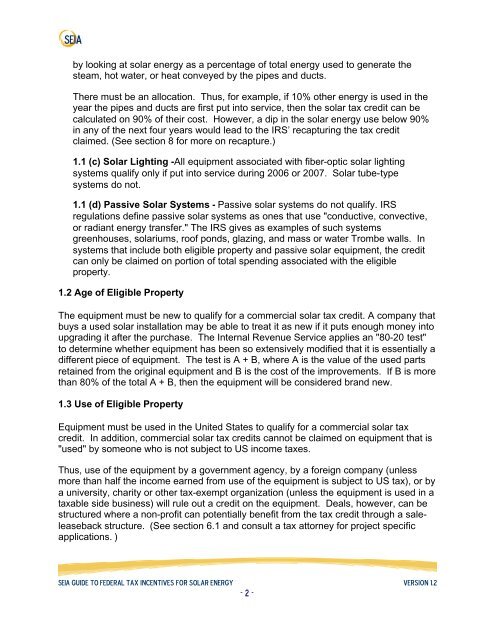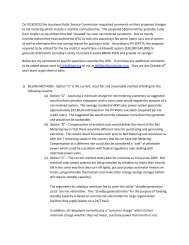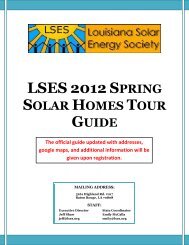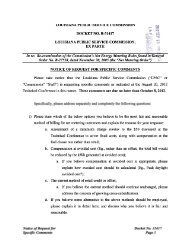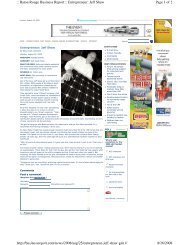SEIA Guide to Federal Tax Incentives for Solar Energy - Solar Power ...
SEIA Guide to Federal Tax Incentives for Solar Energy - Solar Power ...
SEIA Guide to Federal Tax Incentives for Solar Energy - Solar Power ...
Create successful ePaper yourself
Turn your PDF publications into a flip-book with our unique Google optimized e-Paper software.
y looking at solar energy as a percentage of <strong>to</strong>tal energy used <strong>to</strong> generate thesteam, hot water, or heat conveyed by the pipes and ducts.There must be an allocation. Thus, <strong>for</strong> example, if 10% other energy is used in theyear the pipes and ducts are first put in<strong>to</strong> service, then the solar tax credit can becalculated on 90% of their cost. However, a dip in the solar energy use below 90%in any of the next four years would lead <strong>to</strong> the IRS’ recapturing the tax creditclaimed. (See section 8 <strong>for</strong> more on recapture.)1.1 (c) <strong>Solar</strong> Lighting -All equipment associated with fiber-optic solar lightingsystems qualify only if put in<strong>to</strong> service during 2006 or 2007. <strong>Solar</strong> tube-typesystems do not.1.1 (d) Passive <strong>Solar</strong> Systems - Passive solar systems do not qualify. IRSregulations define passive solar systems as ones that use "conductive, convective,or radiant energy transfer." The IRS gives as examples of such systemsgreenhouses, solariums, roof ponds, glazing, and mass or water Trombe walls. Insystems that include both eligible property and passive solar equipment, the creditcan only be claimed on portion of <strong>to</strong>tal spending associated with the eligibleproperty.1.2 Age of Eligible PropertyThe equipment must be new <strong>to</strong> qualify <strong>for</strong> a commercial solar tax credit. A company thatbuys a used solar installation may be able <strong>to</strong> treat it as new if it puts enough money in<strong>to</strong>upgrading it after the purchase. The Internal Revenue Service applies an "80-20 test"<strong>to</strong> determine whether equipment has been so extensively modified that it is essentially adifferent piece of equipment. The test is A + B, where A is the value of the used partsretained from the original equipment and B is the cost of the improvements. If B is morethan 80% of the <strong>to</strong>tal A + B, then the equipment will be considered brand new.1.3 Use of Eligible PropertyEquipment must be used in the United States <strong>to</strong> qualify <strong>for</strong> a commercial solar taxcredit. In addition, commercial solar tax credits cannot be claimed on equipment that is"used" by someone who is not subject <strong>to</strong> US income taxes.Thus, use of the equipment by a government agency, by a <strong>for</strong>eign company (unlessmore than half the income earned from use of the equipment is subject <strong>to</strong> US tax), or bya university, charity or other tax-exempt organization (unless the equipment is used in ataxable side business) will rule out a credit on the equipment. Deals, however, can bestructured where a non-profit can potentially benefit from the tax credit through a saleleasebackstructure. (See section 6.1 and consult a tax at<strong>to</strong>rney <strong>for</strong> project specificapplications. )<strong>SEIA</strong> <strong>Guide</strong> <strong>to</strong> <strong>Federal</strong> <strong>Tax</strong> <strong>Incentives</strong> <strong>for</strong> <strong>Solar</strong> <strong>Energy</strong> Version 1.2- 2 -


